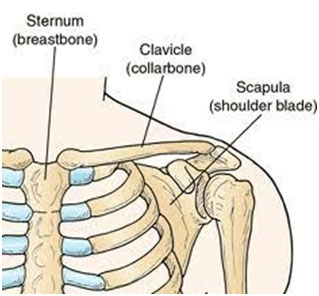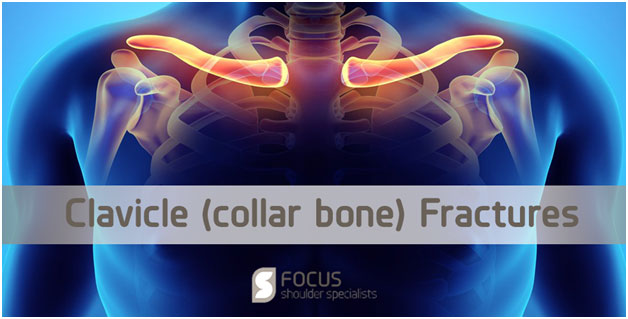Collar bone fractures are also known as clavicle fractures. A fracture means a break and is an interchangeable term.
The function of the collarbone is to act as a connection between the chest wall and the shoulder. When someone is said to have “broad shoulders”, it actually means they have a longer collar bone which holds their shoulder out longer. When a clavicle fracture is sustained the shoulder loses its support mechanism and can slump forward and appear deformed.
Commonly people notice in the mirror that their shoulder is shorter and a visible lump may also be present. This is usually accompanied with pain, a click or sensation that the ends of the bone are moving.

What are the common causes?
The majority occur with contact sports injuries such as football. Cycling accidents are also frequent.
High speed car or motor cycle accidents can result in severe injuries. The type of activity causing the injury often has a direct impact on how severe the injury is and whether any surgery/intervention is required.
Lower speed injuries usually result in a simple break where the collar bone breaks into 2 parts. This is usually in the middle of the collar bone.
High energy injuries can cause the fracture to break into multiple pieces. This is a term called a comminuted fracture.
How is the diagnosis made?
A simple x-ray is required.
When is surgery required?
This is where experience counts! Sure, most clavicle fractures heal on their own but reviewing with a dedicated shoulder surgeon is important. From experience, they can predict which fractures can become problematic in the future.
The factors I look for in assessing whether a patient requires surgery are:
- Dominant arm and level of discomfort
- Age
- General health
- Activities, profession and sports
- Physical degree of deformity
These factors combined with the x-ray characteristics will guide who benefits from treatment in a sling or an operation.
Fortunately for most patients they can be treated simply in a sling with pain relief. If you are assessed appropriate for sling treatment, generally this is to be worn for 4-6 weeks with x-ray observation at 2 weeks, 6 weeks and 3 months. Physiotherapy is important when the fracture has started to heal. Your shoulder surgeon will advise when this can start.
What does the surgeon evaluate on x-ray?
General features assessed are: angulation, shortening, how far apart the fracture ends are, and the number of pieces the bone has broken into.
Case 1: 16 yr old boy fractured clavicle post football injury.
Note the angulation of the bone:

Post surgery with plate and screw fixation:

What is involved with surgery?
If Dr. Dan recommends surgery this will take place as an overnight hospital stay. The technique used requires a general anesthetic. The commonest and favoured technique utilizes a plate and screws to fix the clavicle together. This exercise is similar to putting a jigsaw puzzle together and securing it to allow early motion and rehab.
Case 2: 50 yr old man after a motor bike accident- note how the clavicle is shortened. This resulted in a severe deformity of the shoulder.

Post Surgery:

Dr. Dan believes cosmetic appearance of the wound is important. He uses a skin incision called a bra-strap incision. This technique is technically more difficult but results in less scarring and less problems with the plate being prominent. Most patients especially the female patients are pleased with the scar which can be concealed in the line of a bra-strap. (See image below)

Dr. Dan will review you in the office 10-14 days post surgery with an updated x-ray. Most patients feel much improved compared to before the surgery. They report less pain and even feel comfortable without a sling. The wound is reviewed and the aim is to commence physiotherapy as soon as healing has commenced. For most patients,this means weaning off the sling at 4 weeks post surgery.
Dr. Dan understands that shoulder injuries can cause personal and professional setbacks. His aim is to provide world class treatment to his patients. By focusing his care exclusively on shoulder injuries, a unique understanding and approach has been developed to make your road to recovery as easy as possible.


